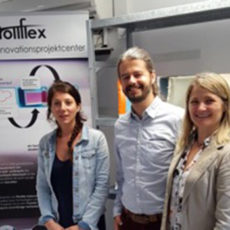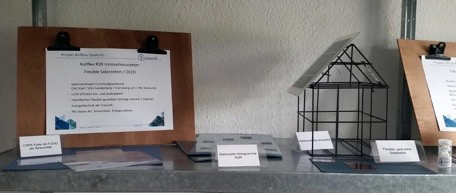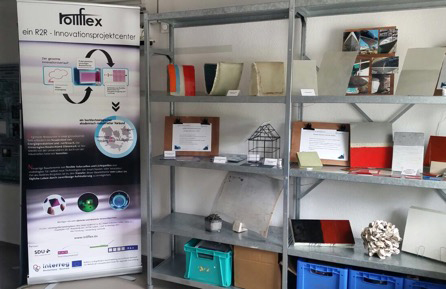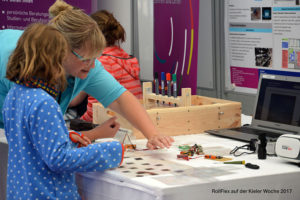Publications in English
Realizing 8 cd A−1 Current Efficiency for Solution-Processed Inverted Top-Emitting Polymer Light-Emitting Diodes Y. Murat, H. Lüder, M. Köpke, J. Buhl, M. Gerken, Journal of Electronic Materials 50 (2021) 2556
Identification of degradation mechanisms in slot-die coated non-fullerene ITO-free organic solar cells using different illumination spectra
B. Arredondo, G. del Pozo, E. Hernández-Balaguera, D. Martín-Martín, M. C. López-González, B. Romero, E. López-Fraguas, R. Vergaz, X. Quintana, J. Lamminaho, E. Destouesse, M. Ahmadpour, V. Turkovic, M. Madsen. ACS Appl. Energy Mater. 3, 7 (2020) 6476
Degradation behaviour of scalable non-fullerene organic solar cells assessed by outdoor and indoor ISOS stability protocols. W. Greenbank, N. Djeddaoui, E. Destouesse, J. Lamminaho, M. Prete, L. Boukezzi, T. Ebel, L. Bessissa, H.-G. Rubahn, V. Turkovic, M. Madsen. Energy Technology (2020)
All solution-processed ITO free flexible organic light-emitting diodes
Y. Murat, K. Petersons, D. Lanka, L. Lindvold, L. Yde, J. Stensborg, M. Gerken, Materials Advances 1 (2020) 2755
OLED OPD Matrix for Sensing on a Single Flexible Substrate
I. Titov, M. Köpke, N. Schneidewind, J. Buhl, Y. Murat, M. Gerken, IEEE Sensors Journal, 20, (2020) 14
Photonic crystal slab between orthogonal polarizers: details on the guided mode resonance wavelength
H. Lüder, M. Paulsen, M. Gerken, Optical and Quantum Electronics 52 (2020) 180
Refractive Index Measurement with a Flexible OLED-OPD Detection Unit. I. Titov, M. Köpke and M. Gerken,
Proc. 2020 IEEE International Conference on Flexible and Printable Sensors and Systems (FLEPS) 1 (2020)
Localized Emission Centres in Nanostructured Emission Layers for an Increased Resonance-to-Background Ratio.
H. Lüder, P. Kreutzkamm, Y. Murat, and M. Gerken, OSA Advanced Photonics Congress (AP) 2020 (IPR, NP, NOMA, Networks, PVLED, PSC, SPPCom, SOF) OSA Technical Digest (Optical Society of America, 2020), paper JTh3G.2
Slot-die processing and encapsulation of non-fullerene based ITO-free organic solar cells and modules E. Destouesse, M. Top, J. Lamminaho, H.-G. Rubahn, J. Fahlteich and M. Madsen, Flex. Print. Electron, 4 (2019) 045004
Inverted organic solar cells with non-clustering bathocuproine (BCP) cathode interlayers obtained by fullerene doping F. Jafari, B. R. Patil, F. Mohtaram, A. L. F. Cauduro, H.-G. Rubahn, A. Behjat and M. Madsen, Sci. Rep., 9 (2019) 10422
Towards solution-processed top-emitting OLEDs using a phosphorescent iridium complex Y. Murat, D. K. Subramanian, A. V. Lakshmanan, M. Gerken, 21st International Conference on Transparent Optical Networks, Angers, France, 09.-13.07.2019
FDTD modelling of nanostructured OLEDs: analysis of simulation parameters for accurate radiation patterns H. Lüder, M. Gerken, Optical and Quantum Electronics, vol 51 (2019) 139
OLED-OPD Matrix for Fluorescence Sensing on a Single Flexible Substrate N. Schneidewind, M. Köpke, J. Buhl, Y. Murat, M. Gerken, IEEE International Conference on Flexible and Printable Sensors and Systems (FLEPS) (2019)
Highly performant organic top-emitting light-emitting diodes (OLEDs) by solution process Y. Murat, H. Lüder, M. Gerken, Proc. Light, Energy and the Environment Congress, pp. SW2D-1 (2018)
Area-dependent behavior of bathocuproine (BCP) as cathode interfacial layers in organic photovoltaic cells Bhushan R. Patil, Mehrad Ahmadpour, Golnaz Sherafatipour, Talha Qamar, Antón F. Fernández, Karin Zojer, Horst-Günter Rubahn & Morten Madsen, Nature Scientific Reports (2018)
Dynamics of photoinduced degradation of perovskite photovoltaics: from reversible to irreversible processes M. V. Khenkin, et. al. , ACS Appl. Energy Mater., 1, 2 (2018) 799
Reconsidering Figures of Merit for the Performance and Stability of Perovskite Photovoltaics M. V. Khenkin, et. al., Energy Environ. Sci., 11 (2018) 739
Modeling Multi-junction Solar Cells by Non-Local Tunneling and Sub-Cell Analysis. Y. Liu, M. Ahmadpour, J. Adam, J. Kjelstrup-Hansen, H.-G. Rubahn, M. Madsen, IEEE J. Photovolt., 8 (2018) 1363
Cu(II) and Zn(II) based Phthalocyanine as Hole selective layers for Perovskite Solar Cells L. Calio, et. al., Sustainable Energy Fuels, 1 (2017) 2071
Simulation methods for multiperiodic and aperiodic nanostructured dielectric waveguides Paulsen, L. T. Neustock, S. Jahns, J. Adam, M. Gerken, Opt. Quant Electron., 49 (2017) 107
Simulation of nanostructured emission layers for tailoring the angular radiation pattern of OLEDs. Lüder, M. Bremer, M. Gerken, Proc. International Conference on Electromagnetics in Advanced Applications (2017)
Organic optoelectronics for lab-on-chip fluorescence detection
S. Jahns, A. F. K. Iwers, J. Balke, and M. Gerken, tm – Tech. Mess., vol. 84(s1) (2017) 48
ITO with embedded silver grids as transparent conductive electrodes for large area organic solar cells R. Patil, M. Mirsafaei, P. P. Cielecki, A. L. F. Cauduro, J. Fiutowski, H.-G. Rubahn and M. Madsen, Nanotechnology, 28 (2017) 405303
4P-NPD ultra thin-films as efficient exciton blocking layers in inverted DBP/C70 based organic solar cells B. R. Patil et al., J. Phys. D: Appl. Phys., 50 (2017) 385101
Current Matching in Multifold DBP/C70 Organic Solar Cells with Open Circuit Voltages of up to 6.44 V M. Ahmadpour et al., IEEE J. Photovolt., 7 (2017) 1319
The influence of electrical effects on device performance of organic solar cells with nano-structured electrodes M. Mirsafaei et al., Sci. Rep., 7 (2017) 5300
Tetrapodal ZnO Particles for Substrate Mode Scattering in Flexible Organic Light-Emitting Diodes M. Bremer, A. Cojocaru, I. Hölken, I. Paulowicz, M. Köpke, R. Adelung, H. Schmidt-Niepenberg, and M. Gerken. Light, Energy and the Environment, OSA Technical Digest (online) Optical Society of America (2016), paper JW4A.8
Publications in German
Produkte von der Stange? Nein, von der Rolle
NINa-Newsletter 6/2017
Publications in Danish
Printede solceller som hvermandseje
Aktuel Naturvidenskab Nr. 6, 2016 | Kort nyt, s. 4 | Birgitte Dalgaard, SDU


















